
Yokosuka
D4Y2-S 'Judy'
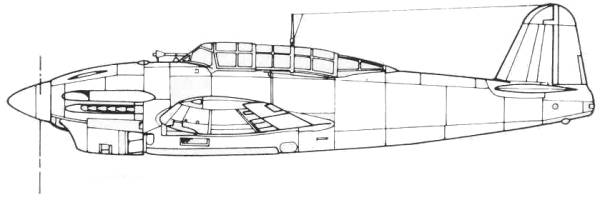
Impressed
by
the Heinkel He 118V4, which the Japanese had acquired from the
Germans along with production rights, The Naval staff in late 1938
instructed Yokosuka to design an aircraft inspired by, but smaller
than
the He 118V4 to meet the requirements of a Navy Experimental 13-Shi
Carrier Bomber specification. Although the design was inspired by the
He 118 the engineers had succeeded in producing an air frame which was
not only smaller and lighter but which was much improved
aerodynamically. It was planned to power the aircraft with a license
built version of the Daimler-Benz DB 601A, the Aichi Atsuta, but the
Japanese engine was not available when the first prototype was being
built and a DB 600G was used instead. The first D4Y1 was completed in
November 1940 and made its maiden flight at Yokusuka the following
month. Performance exceeded the Navy's most optimistic hopes and the
trials were accelerated in 1941, when four additional prototypes were
delivered. When simulated dive bombing tests were made, the aircraft
ran into trouble as wing flutter developed and cracks appeared in the
wing spars. Consequently, plans to mass produce the aircraft in the
Nagoya plant of Aichi had to be hurriedly changed as it was obvious
that it was not ready to be operated in its intended role.
Initially,
the
pre-production D4Y1's, which began rolling off Aichi's assembly
lines in the spring of 1942, differed from the Yokosuka built
prototypes only in being powered by the 1,200 hp Aichi AE1A engine.
With its maximum speed substantially higher than that of the Nakajima
B5N2 operated as a reconnaissance aircraft, and with good range
performance, the Atsuta powered D4Y1 appeared to be ideally suited for
that role. Accordingly the Navy instructed Aichi to modify the the
aircraft as the D4Y1-C carrier borne reconnaissance aircraft by
mounting a K-8 camera in the aft fuselage. In July 1942 the D4Y1-C was
ordered into production. Production was slow in gaining tempo as the
requirements for these was limited and by the end of March 1943 Aichi
had only completed twenty-five D4Y1s and D4Y1-Cs including
preproduction aircraft. Small detachments of the D4Y1-Cs were
beginning
to be assigned to carriers in the autumn of 1942 and the type remained
in first line service until the end of the war. Fitted with two 330
liter drop tanks, the D4Y1-C had extensive range and the aircraft was
liked by its crews who complained only of lack of pilot and fuel tank
protection, while ground crews experienced some difficulty with the
liquid cooled engine.
Development
of
the D4Y1 continued and fitted with a reinforced wing spars and
improved dive brakes, it was finally accepted as a dive bomber in
March
1943. As there was a demand for a fast aircraft capable of
supplementing and eventually supplanting the obsolete Aichi D3A2,
production was rapidly sped up and most of the 589 D4Y1s and D4Y1-Cs
built by Aichi between April 1943 and March 1944 were of the dive
bomber variant. A considerable number were shot down during the
Marianas 'turkey shoot' and they failed to sink a single American
carrier. In spite of the lesson of the battle for the Marianas, the
next
production version still had no provision for either crew or fuel tank
protection and the modifications were limited to the installation of
the 1,400 hp Aichi AE1P engine. Designated the D4Y2 this variant
entered production in October 1944. entering service during the battle
for the Philippines, the different D4Y2 variants were decimated by the
numerically superior allied fighter aircraft and a large number of
them
were expended in kamikaze attacks.
The
11th
Naval Arsenal at Hiro undertook the modification of a limited
number of D4Y2s intended to operate in the night fighter role. For
this
duty the bomb racks, flexible rear firing guns and carrier equipment
were removed and the internal bomb bay was faired over. A single 20 mm
Type 99 Model 2 cannon was mounted obliquely in the fuselage to fire
upward and forward at a 30º angle. Some of the aircraft were also
equipped with wing racks for air-to-air rockets. Designated the D4Y2-S
these aircraft were used with limited success from bases in Central
Japan against low flying B-29s operating at night. Lacking AI radar
and
having a slow climbing speed, the D4Y2-S was rather ineffective as a
night fighter.
The
Kit
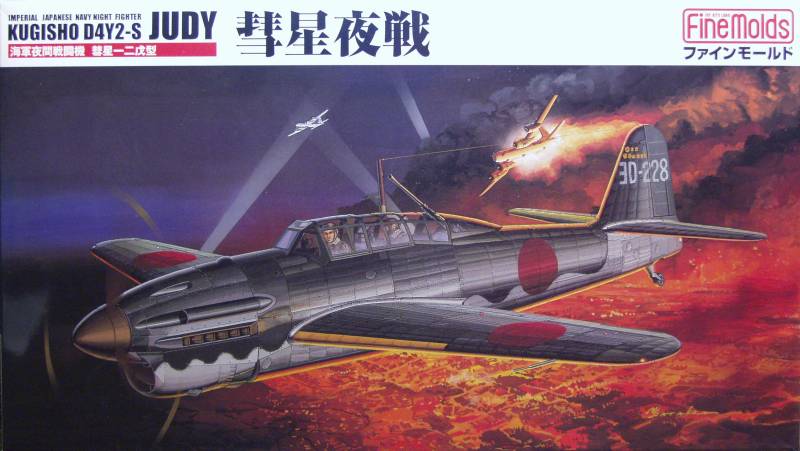
The FineMolds Judy comes in a top open box with nice artwork on the
top. Inside the contents is contained in three cellophane bags. One
contains three sprues in medium gray plastic that contain the fuselage,
wings, tail, internal parts, landing gear and various in sundry parts
including a standing pilot figure with map case. The second bag
contains the liquid cooled engine and an assortment of parts specific
to certain versions. The engine was molded as a separate assembly so
that the radial engine version could be modeled as well, The third bag
contains the clear parts and decals as well as a small bag including
three cast metal parts that make up the 20 mm gun used in the night
fighter version. The air frame parts feature recessed panel lines which
are quite fine and some raised surface detail where applicable. The
finish is glossy. There is some flash on some of the parts but it
shouldn't be hard to clean up. There were also some sink marks on the
fuselage opposite the interior molded detail. The wheel wells feature
some molded in
detail. All flight control surfaces are molded in the neutral position.
Due to the
thinness of the horizontal stabilizers and the vertical tail
these parts are molded in one piece rather than halves as is the
usually case. Two tails are provided and usage will depend on the
markings choice you make. Some detail is molded into the inside of the
fuselage as shown in the photo below. For the most part ejector pin
marks have been keep out of visible areas but the are a few, most
notably on the inside of the landing gear doors. Parting lines
on parts not molded in half are within reason. The cockpit is
reasonably well appointed and should satisfy most. The instrument panel
is supplied only with a decal, there is no raised bezel or instrument
detail. There are a number of parts that won't be used as the kit
contains some of the parts that would only be used on the dive bomber
or recon version. The pilot figure is quite well molded and if you are
talented in figure painting should look quite nice painted up. The
propeller is of the multi part type and the blades are not keyed so
some care is required to get them set at the same angle. See
photos of the sprues below.
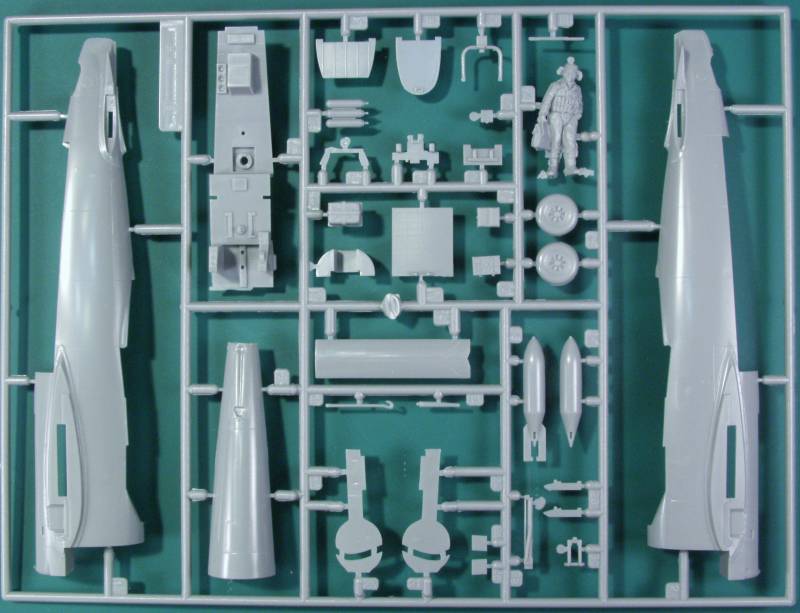
An enlarged view of the
inside of the fuselage showing molded in detail.
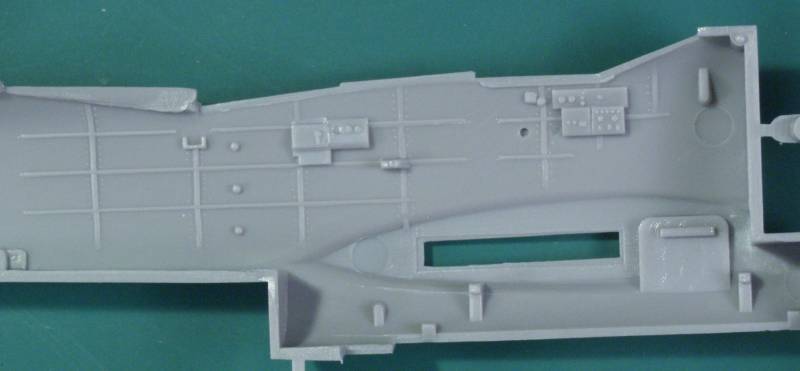
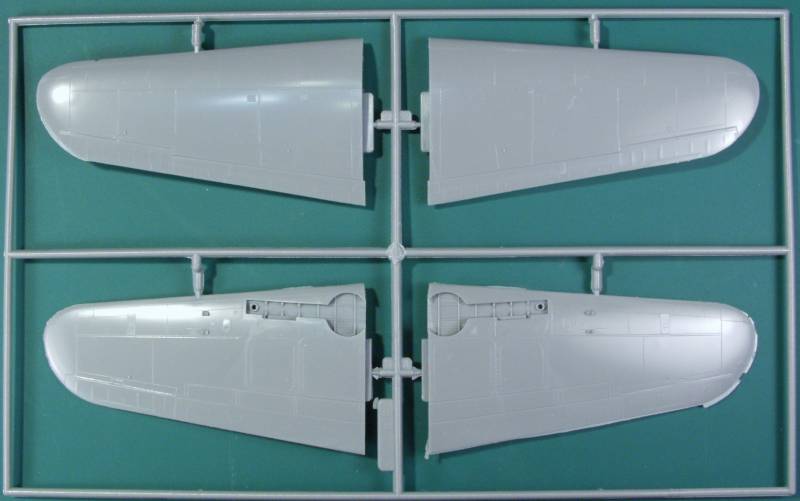
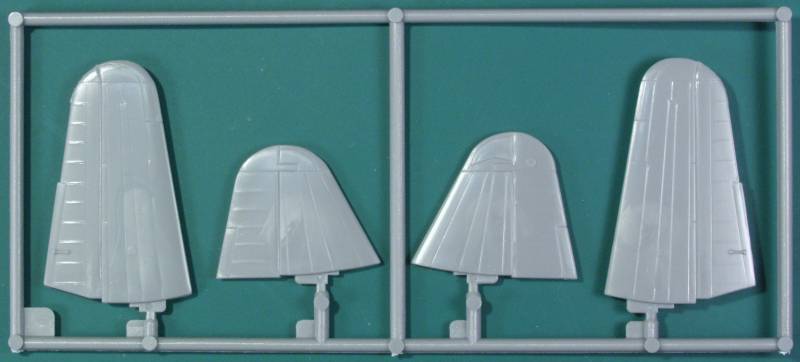
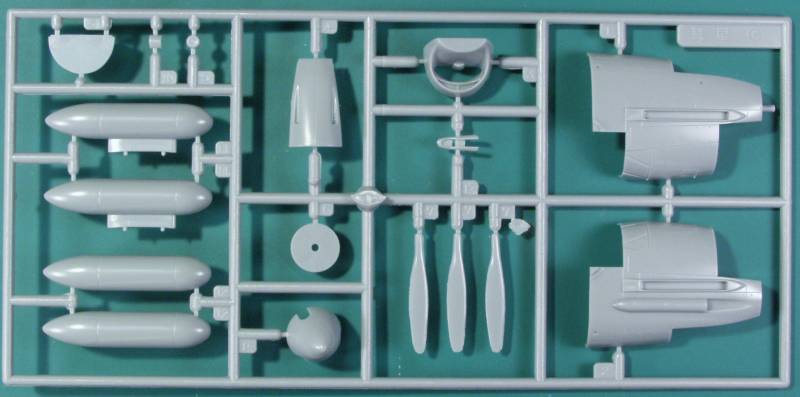
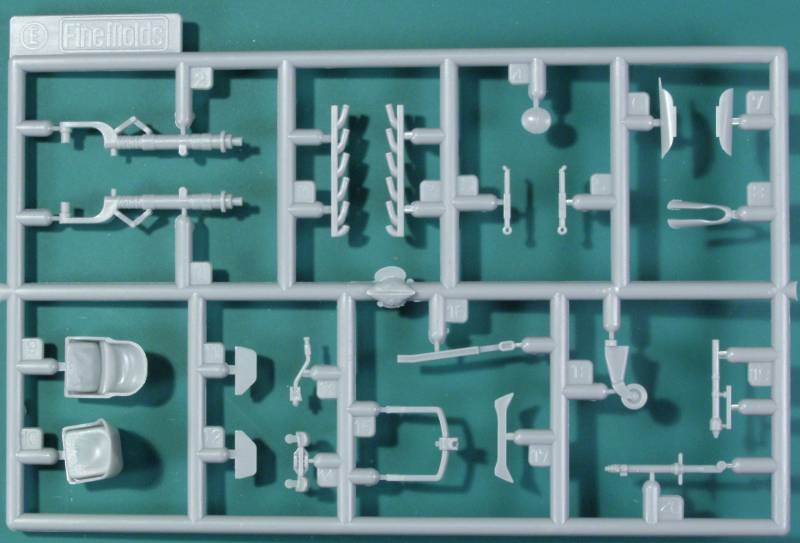
The
cast metal cannon has a rather heavy parting line to clean up and it
might be worth while to replace the barrel with a piece of hypodermic
tubing.
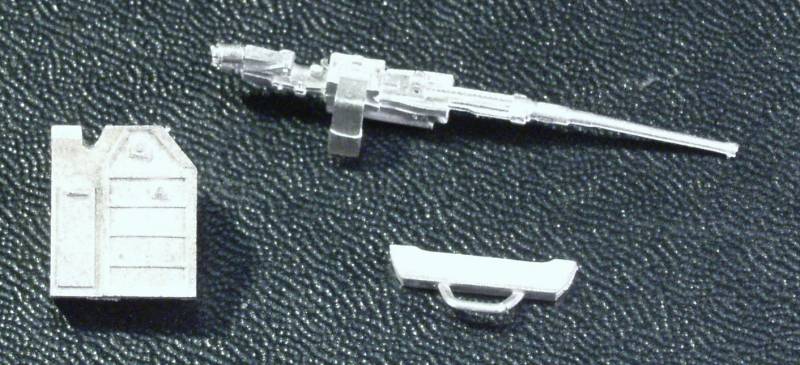
The
clear
parts are a bit thick and not as clear as some of the more
recent
kits. The frame likes are are well defined but there is no
option for
opening the canopy. Hopefully a dip in Future will improve their
clarity.
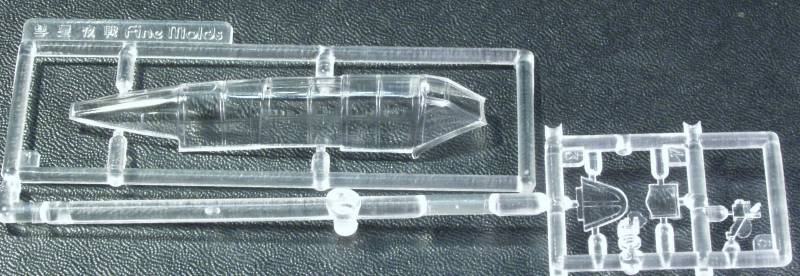
The
decals
appear opaque and perhaps a bit thick with minimal clear film.
The white seems to be more of a cream color similar to what was
supplied with Hasegawa kits for years. A fair amount of stencils
are
supplied. Registration isn't an issue as the white surrounds are
supplied as separate decals and alignment is left to the
installer.
This really isn't an issue as the main sheet is apparently the
one
supplied with the other versions of the kit as the national
markings on
this kit don't have the white surrounds. A second sheet was
supplied
which has the special markings for this kit. Markings are
supplied for
five different aircraft from different flight groups. See below.
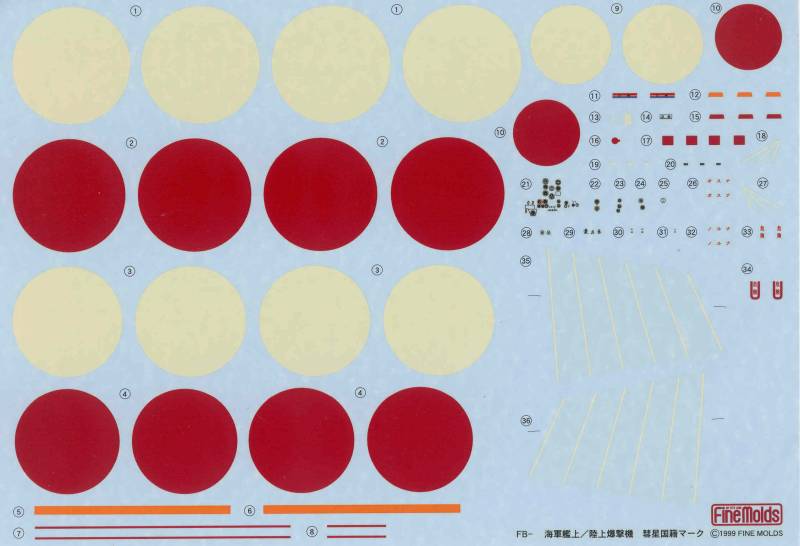
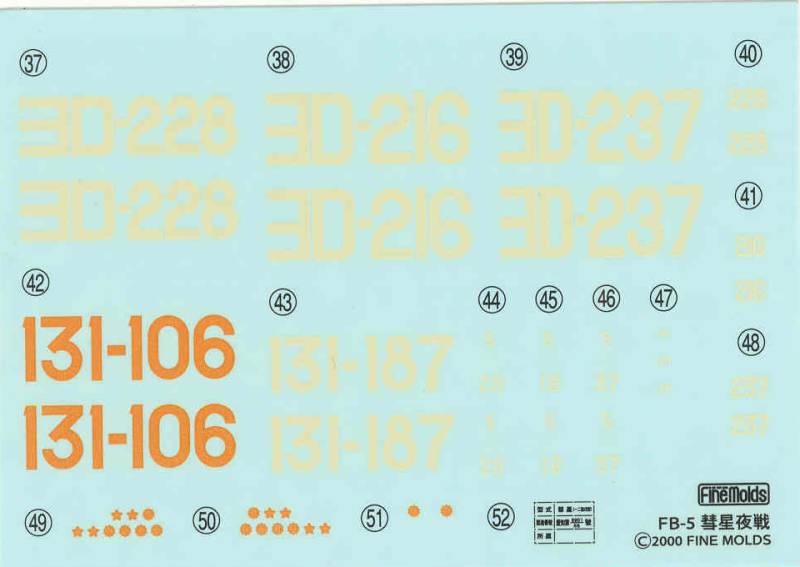
The
instructions
are in the form of a long folded sheet which
consists of 8
panels. Unlike many kits from Japan the
instructions are predominately
in Japanese. The cautions are duplicated in
English as are part numbers
and color names but there are notes and such on
some pages in Japanese
only. Most of the diagrams are self explanatory so
hopefully this won't
be that much of an issue. Be careful when
installing the vertical tail
piece as one of the marking sets uses an
alternative piece. The
assembly is broken down into 14 steps over 6
panels, the last two
panels detail the paint and marking locations.
again most of the
information is mostly in Japanese with color names
and decal numbers in
English. An additional folded page is included
with what I assume is
history of the aircraft and a brief description of
three of the pilots
that flew the aircraft depicted in the various
markings supplied. There
are also some maps and other details about the
aircraft and additional
details that were apparently available at the time
of the kits release.
Once again this is all in Japanese so it was not
helpful unless you can
read Japanese.
After
Market
Goodies
The
only thing item I chose to get for this kit was a set of resin
exhausts
from Quick Boost. They will save me from trying to hollow out
the ends
of the exhaust stubs. The Quick Boost part number is QB 48283.
See
below.

Squadron
apparently makes or made at one time a vacuform canopy for those who
want to open it up or have one a bit thinner, however, it is for the
standard variants of the D4Y2 and the night fighter version used a
different wind screen so to be accurate the kit windscreen would need
to be used. Eduard makes a canopy mask for it, their number Xf133.
Conclusions
This
appears to be a nice kit however it should be treated as you
would a
limited run kit ans don't expect the fit to be up to
Hasegawa or Tamiya
standards. Recommended for modelers with some limited run
kit
experience.
Links
to kit build or reviews
There is an inbox
review here
of the non night fighter version and a build / review here.
References
Japanese Aircraft of the
Pacific War by R.J. Francillon
Back to the Misc Japanese page
Updated 12/31/13













